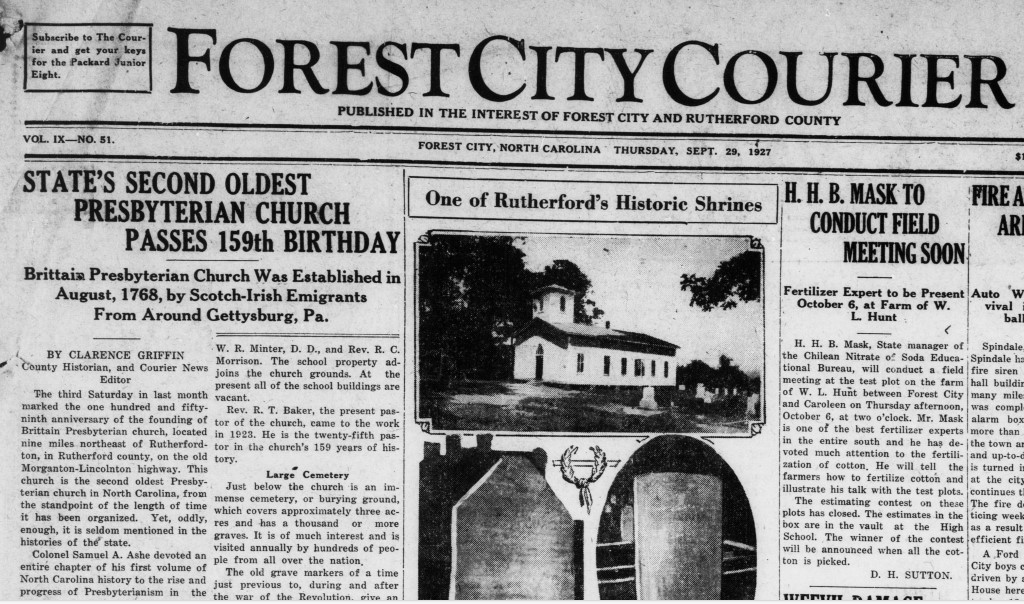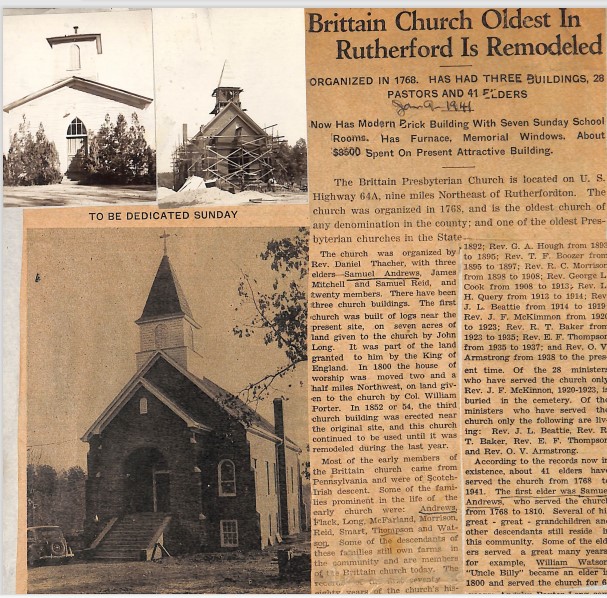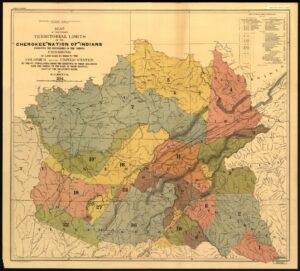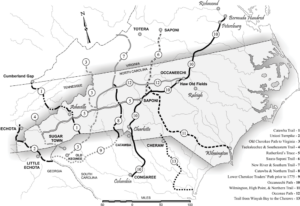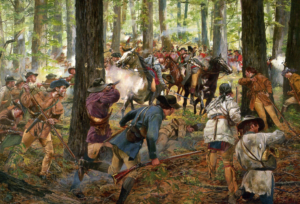Brittain Church Graveyard and Biggerstaff Hanging Tree Tour Recap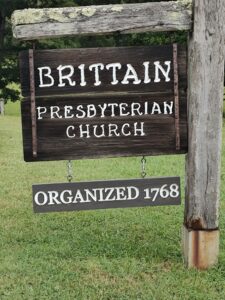
Trevor Freeman – Asheville Museum of History Public Programs Director
This is the second year we at the Asheville Museum of History have hosted a cemetery series, and this tour was the first event in the 3-part 2023 iteration.
When we led the series last year, we knew people were very interested in cemeteries, but wanted to know, “why?” We found it is not just the macabre, or any haunted lore; It’s the people and stories told by these markers and burial places that seem to draw everyone in.
I made it the goal this year to humanize history, as that’s what we were doing all along. We often hear about the “great men” or prominent figures but then large groups of people in history, but others – revolutionaries, serfs, the enslaved, soldiers, Natives, pirates, hillbillies, etc. – are largely nameless and faceless. Yet their stories are intertwined with much larger trends and patterns – many of them collectively helped to shape history. Often, these people have passed without any mark, and stones are all that remain, if even that.
A great example of what we hope to achieve with this series is exemplified by a 2023 article in the Bitter Southerner Magazine written by WNC writer Jeremy B. Jones. He penned an obituary for a quite ordinary life that was nevertheless vibrant and full of meaning.
Brittain Presbyterian Church
- Before the church, Fort McGaughey was built nearby in 1765 by Alexander McGaughey who moved here from Pennsylvania.
- The church was chartered and built in 1768 and is rumored to be the second oldest organized Presbyterian church (congregation with a building, congregation, established minister) in NC. It was certainly the first dedicated church building constructed in WNC.
- Reverend Daniel Thacker and three elders – Samuel Andrews, James Mitchell and Samuel Reid – established a small congregation and churchgoers constructed the first church building on the site, a small log structure.
- It was Initially founded as Little Britain church but the spelling changed after the American Revolutionary war, and the church moved about two miles away in 1800.
- The congregation built the third iteration of the church back here on the same ground in 1852, and it brick was veneered in 1940.
Cherokee Land
This cemetery gives us a great chance to talk about the settlement of WNC. Here, as everywhere we venture in WNC, is Cherokee land. The Aniwviya – meaning principal people – as Cherokees call themselves, have been here thousands of years. And of course, that means they also did a great deal of burying deceased loved ones themselves.
Ancestors of the Cherokee moved to this area of the Southern Appalachians more than 10,000 years ago and were part of a vibrant and dynamic network with other peoples across the Southeast, long before any Europeans arrived.
This area we are in today was not the site of any permanent towns, but was part of Cherokee hunting and harvesting lands. This would have been toward the outer edge of the Cherokee territory, and also closer to the Catawba homeland.
However, based on recorded Cherokee stories, some scholars believe a trade route from those lower towns in SC ran through here (modern Rutherford County) north to western Virginia.
As the presence of McGaughey’s and other forts suggest, the Cherokee did not easily give up their lands to the squatters and they were not passive observers, but active participants, negotiators, warriors, and diplomats during these several decades around the birth of the United States. They officially held this land until a treaty in 1777.
Settlement and the Great Wagon Road
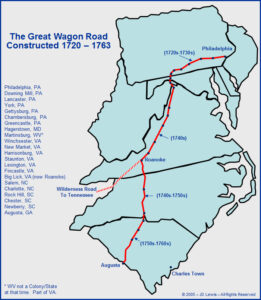
The burials in the graveyard illustrate the influence of the Great Wagon Road migration from Pennsylvania into the backcounty of the Carolinas in the mid-1700s.
- Settlers seeking new land migrated into western Virginia heavily in 1740s and were pouring into the Carolina backcountry by 1750s.
- My own family came from Massachusetts in the late 1600s, made their way into Virginia in the mid-1700s, and then were documented in Carolina foothills here around 1775.
- The first migrants were largely Scots-Irish and Presbyterian, but then Germans (including many Quakers and a few Moravian groups) migrated. A few of the early settlers began to bring or import enslaved people of African descent into the region as well.
- In the cemetery there are several burials of people born in or migrating from Pennsylvania including:
- John Smart
- Isabella Jean McGaughey Smart (born in either Scotland or York, PA, died 1790)
- John Flack, a founding church member (b.Bucks County, PA, d.1792)
- Sarah Watson Mitchell (b.York County, PA, d.1797)
- Patrick Watson (b.York County, PA, d.1809)
- And many others
Spread of Presbyterians
- In 1758 the Hanover Presbytery covered VA and NC. Brittain Church was first part of the Hanover Presbytery and then Orange in 1770. Later it fell under the Mecklenburg Presbytery and now is part of the WNC Presbytery along with 94 other churches.
- In 1776, there were 300 total American Presbyterian churches compared to 380 Baptist, 300 Episcopalian, and over 700 Congregationalist.
- Most early Presbyterians congregated in New York, New Jersey, or Pennsylvania.
- Most early congregations did not have a permanent church, but used houses or, commonly, brush arbors constructed outside for week-long revival meetings.
- From the 1758 meeting of Hanover Presbytery: “Mr Miller agrees to preach one Sabbath at Major Brown’s Meeting House and one in the Calf Pasture betwixst this and our next Presbytery.”
- Traveling itinerant preachers served the spiritual needs of mountaineers while these large gatherings also served communal and social needs. Preachers such as Francis Asbury, who largely brought Methodism with him into the mountains in the early 1800s, made yearly pilgrimages in rough conditions because, as he stated: “My soul felt for these neglected people.”
- Presbyterians were gradually surpassed in popularity by Baptists and Methodists. In 1815, Presbyterians in North Carolina counted around 4,000 full members, but probably 16,000 attended meetings periodically. But as early as 1796, NC Methodists numbered over 7,000 and had an estimated 2.5 that number as occasional attendees.
Graveyard Burials
Patterns
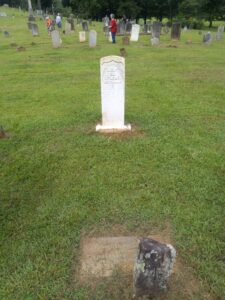
- There are 779 known burials at Brittain Church.
- The oldest NOTED burials are John Smart Sr. and Lt. Thomas McCullough. Both died of wounds received at Kings Mountain, October, 1780.
- The most recent burial is from 2023.
- In the back lower portion of the cemetery you see several rough fieldstones and mostly plain, unadorned slate and limestone headstones until roughly the 1820s when we start seeing fancier scrollwork.
- These more decorative markers were popular in New England and along the coast several decades earlier but may have slowly spread west.
- There are also numerous replacement markers which were erected at some later date.
- By the 1830s, headstones reflect standardized lettering (indicating professional carvers) and some symbols, though many continued to be rough carved field stones.
- Obelisks began appearing in the 1850s.
- From roughly the 1870s onward, headstones began displaying variation and some truly elaborate features, while many still utilized simple hand-carved markers as well. I hypothesize that this happened during the period of increasing Southern industrialization when there emerged more of a divide between professionals and classes.
We noted several headstones and markers listing women as “consorts” of someone and discussed the possible meanings. Rather than indicating an unmarried couple or a remarriage, there is a perhaps simpler explanation born out in other early American cemeteries. In the 18th-19th centuries, while either spouse could historically be considered the consort of the other, this was most frequently a label given to a wife. When it appears on headstones, it most often indicated a wife who died before a husband.
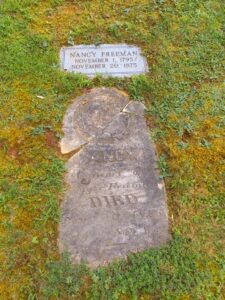
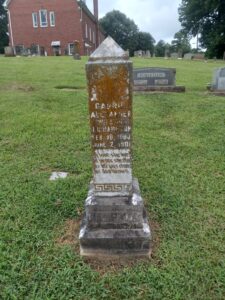
Child and Mother Mortality
We frequently notice the high mortality rates of children and mothers in these older cemeteries. At Brittain, there are very few noted infant burials in the earliest years. I surmise they were buried but unmarked/listed. The first marked child burials appear in the 1820s, and large numbers are seen even into the 1880s.
Then related are the number of women who died during complications from childbirth. Their stories are often hard to piece together but headstones marking deaths between ages 17-40 are possible indicators.
Political Names
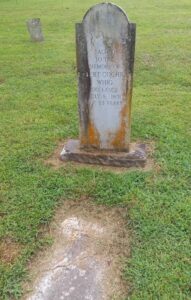
Cemeteries also frequently can show us something about political affiliations and positions within a community based on honorific names given to residents. At Brittain Church, political names include Thomas Jefferson Hampton, a Civil War Confederate soldier who died 1919, and Robert Lee Johnson, born 1881. Robert Cochran who died in 1851, also has a later headstone labeling him simply as a Whig.
Unusual Stories
- In the research process I discovered two of my distant relatives (first cousins) married and were buried here.
- Columba Cardinal was born 1888 in Italy and died 1981.
- One really interesting story is that of Robert “Big Bad Bob” Andrews who was born and lived in New Mexico. It appears he may have had Pueblo ancestry as he started a Pueblo pottery company in Albuquerque. Before his death in 2022, he chose to be buried here where his great grandfather Samuel Andrews helped established the church.
Military Veterans
- Sixteen Revolutionary War soldiers were buried at Brittain Church, two of whom died in action.
- There are several others who served in militia or army regiments in the post-war period, likely during the War of 1812.
- The two Civil War casualties include Hezekiah W Johnson, who enlisted in March 1862, just a month before the Confederate conscription or draft act. The act made men and boys age 16-35 eligible for a draft. Johnson died in Raleigh in May without seeing combat (possibly from dysentery or a camp disease). He was counted as 35 yrs old – the maximum age for draftees.
- William M Erwin, about 25, died at Petersburg, Virginia in August, 1862, after his Confederate unit had returned to NC. It is not clear but certainly possible that he died from wounds or disease.
Patriots and Loyalists (War in Backcountry)
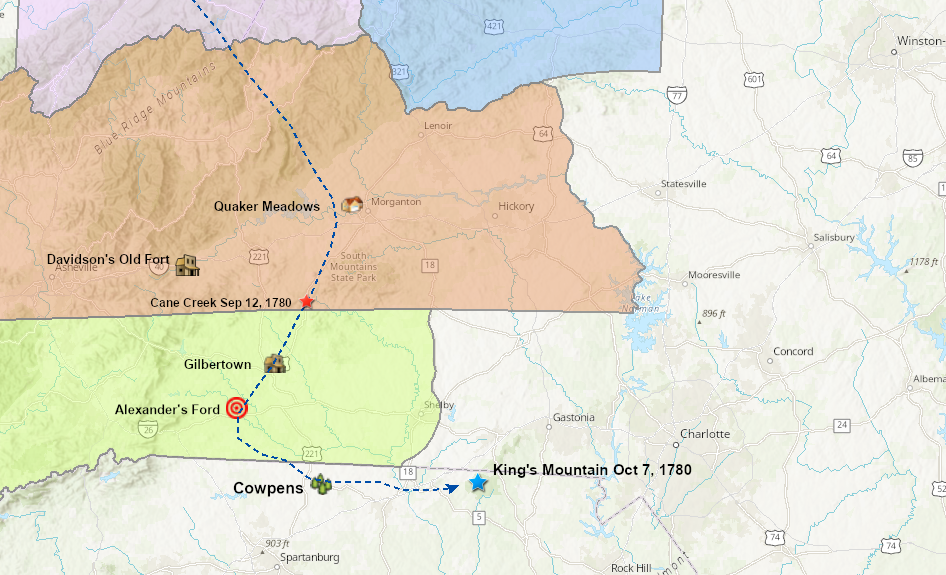
- We discussed those first military veterans buried at Brittain Church as their story leads into the Biggerstaff site.
- In early September, 1780, the British Major Patrick Ferguson, with an army of Loyalists and Provincial soldiers (those from the Americas Loyal to the King and fighting in his service) moved into the foothills near modern Rutherfordton and encamped.
- This brought divided loyalties to a head and induced pragmatic decisions as the war was suddenly at the doorsteps.
- Ferguson’s Lt. Anthony Allaire noted in his diary that “The poor, deluded people of this province began to be sensible of their error, and come in [to British protection] very fast.” They included entire families, women, and children.
- Sept 12, Ferguson’s forces marched past the church in route to the head of Cane Creek (Some 6 miles north) and fought a small skirmish with local Patriots or rebels.
- By the end of September, after he had gone as far as modern Old Fort in search of rebels and provisions, Ferguson had raised over 500 loyalists “over half of whom are first class and armed.”
- The “Overmountain Men” began to gather in late September in TN and VA to go after Ferguson.
- These backcountry militia from NC, SC, VA, GA, and what is now TN number around 1,800 and began to track Ferguson expecting to strike him in Gilbert Town.
- Oct 4-5, most of them marched through here and Oct 7, they catch and surround Ferguson at Kings Mountain, about 40 miles southeast of the church.
- Ferguson’s force of over 1,000, many of whom were from this area, were thoroughly defeated and Ferguson himself was killed.
- Over 200 Loyalists were killed, over 100 injured severely, and around 700 captured.
- By comparison, the patriots or rebels lost about 28 killed, with some mortally wounded and dying later.
- They included John Smart and Thomas McCullough. Smart died in battle and was buried here where his parents later buried.
- McCullough was from VA and served in William Campbell’s VA regiment. He was mortally wounded and brought back here as the army returned. He died Oct 12, 5 days after battle.
- For the captured Loyalists though, their fate is better explored at the Biggerstaff site.
Biggerstaff Hanging Tree
As opposed to Patriots or rebels buried in marked graves at church, here Loyalists were executed and unceremoniously buried.
Who Were the Loyalists
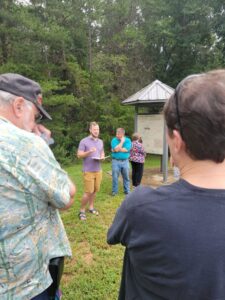
- A spectrum – many people did actually directly bear arms and fight, but other people were accused of Loyalism or treason for making disparaging remarks about the Patriots, not taking oath of allegiance, for providing food/shelter, or for taking protection (getting a parole and agreeing not to fight) from the British.
- Some were turncoats or made temporary/pragmatic decisions.
- Some historians have noted that being a “Loyalist” (that is, being a loyal subject of the King and the royal government) was the default at the beginning of the war.
- Loyalists, at least the famous and ideologically outspoken, were concentrated along the eastern coast and in port cities.
- Backcountry settlers were largely more concerned with Natives. Many who were later Loyalists fought alongside later rebels against the Cherokee and other Native tribes.
- In my own research, I’ve been working on for 2 years now, trying to identify Loyalists of all degrees here in the backcountry of WNC and find out how they were reintegrated not just immediately after the war, but in the following decades. All together, I’ve identified maybe over 400 people who lived in the backcountry who were accused of, convicted of, or could be seen as supporting Loyalism in some way.
- Some were locally notorious such as Ambrose Mills.
- I emphasize – the war in the backcountry was a civil war. Individuals committed frequent brutalities against one another and both sides blamed the other.
- Often, these cruelties – whippings, burning houses or stealing crops and goods, even outright murder, drove otherwise neutral or fence-sitting people into arms on one side or the other.
- While we often think of the “Patriots” those who fought for American independence as the good guys, certainly those in the Loyalist camp did not think so.
The War Arrives

- The British took Savannah, GA in December, 1778 and Georgia became a Royal colony again.
- As a result, militia activity in the backcountry ramped up especially as Loyalists captured the backcountry post at Augusta, Georgia in January, 1779.
- Then in Feb and March, militias and some regular soldiers fought battles at Kettle and Briar creeks on the GA/SC border. Both Loyalists and rebels from WNC fought in militias in these battles.
- During this time, rumors of Loyalist plots and insurrections abounded across NC, including here in backcountry.
- British General Cornwallis later claimed Ambrose Mills was the first in the area to rise to the British cause.
- Court records tell us about this increased activity.
- July 1778, Andrew _ testifies before a judge that Joseph Johnson and Stoffel Ryder were offering recruiting bounties to join the kings army – 50 acres of land, 100 pounds, daily wage, and exemption from taxes – that they were to rendezvous with the army at Burke Courthouse. This deponent also testified that Johnson was saying that almost all of Burke Co had turned for the King.
- William Piles then testified that Johnson had administered to him the oath of allegiance to the king and that his step-father William Wood was to provide arms and ammunition. Others testified he was planning to release prisoners from Tryon Co jail (modern Lincolnton).
- Further north in Wilkes County, Colbert Blair testified that Vezey Husbands (a cousin of Herman Husbands, the famous leader of the Regulators in 1771) was trying to recruit him to the Loyalist side. According to Blair’s testimony, Husbands came to him, swore him to secrecy, and said the war would soon come here. That British General Howe was soon to leave Philadelphia and land here or in Virginia.
- He also indicated that several Patriot militia officers were going to resign their commission out of fear. He supposedly came back to Blair soon and said he was mistaken and to forget about his invitation. All together several people were implicated.
- This was a very common sentiment among those accused or in testimony against them – essentially that the war was coming, and they had to make a decision. Choosing the wrong side might be deadly, while choosing to be neutral could still leave people subjected to harassment or suspicion by either or both sides. The safest bet may have been, in many eyes, to pick the side that was winning or going to win.
- Others in the backcountry came before judges to testify against neighbors for other forms of disloyalty.
- Jacob Sidney in Tryon County (modern Rutherford) was accused of damming “the liberty money and those who made it for it was good for nothing.”
- James Chitwood (who actually would be hung after Kings Mountain) was also accused of making a toast to King George.
- Lastly, while I mentioned most people were not overly ideological, at least one accused Loyalist Henry Daniel was incredibly combative.
- At an appearance before a judge in 1778: “being asked why he had not taken the oath of allegiance he said he would not take it he hoped God would keep him from the mark of the beast nor would he defend their cause for he never had justice done him from the [station?] he also said that he was [face?] from them and the devil might _ before he would. He also said that if he was put into the continental army he would shoot the first officer that would offer to command him and as many as would offer to do it, he also said that if he was taken by any arbitrary power so that he would be a sufferer he would take the life and all lives of all and every such person and they might depend on it and also that he was not a subject of the united states nor under its laws nor ought to laws to have any concern with him.”
- As you can see, even before the war literally came to their doorsteps, there were several people anticipating and beginning to make calculations or plans.
- We’ve already talked a bit about Ferguson’s presence and the battle, so let’s pick that story up again as the battle is ending.
Aftermath of Kings Mountain
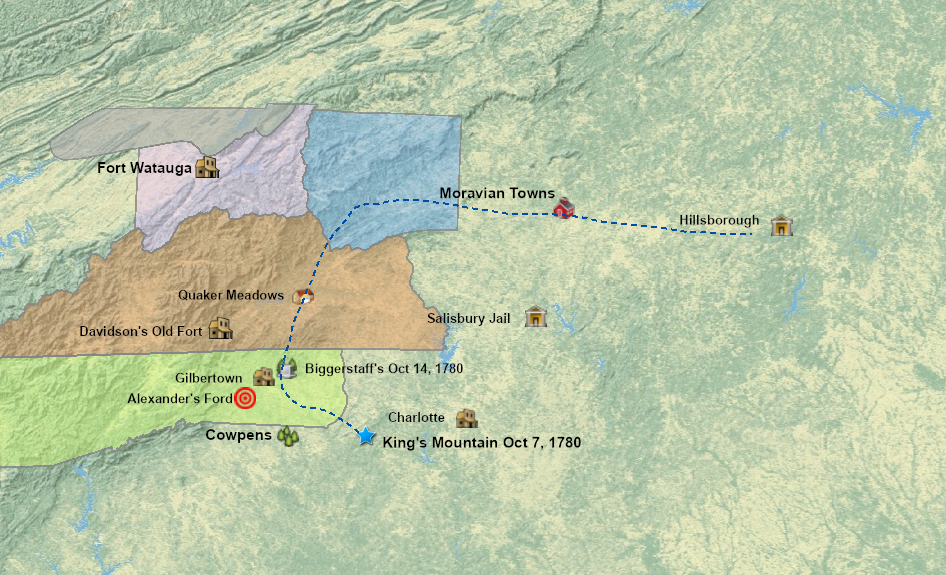
- For the Loyalists captured after Kings Mountain, their fate did not look good.
- The next day, Oct 8, Overmountain rebels start marching back toward Gilbert Town but had no solid plan for dealing with prisoners. Most of them thought their mission was over and simply wanted to return home, and by Oct 14, the commander William Campbell issued an order that none of them could return home until the prisoners were transported somewhere permanent.
- Some wanted to take them to Salisbury, others to Virginia.
- For one thing, the rebels are starving. They travelled with little food and it was exhausted by this point, so they turn to raiding farms along the return march. It did not matter if residents were Patriots, Loyalists, neutral. They helped themselves to clothing, including shoes, from Loyalists as well. The Loyalists did not receive any food but leftover scraps.
- One captured Loyalist described someone who tried to escape being hacked to pieces. But many did escape over the following days.
- Loyalist Lt. Anthony Allaire wrote in his journal that “the whole of the Rebels’ conduct from the surrender of the party into their hands is incredible to relate. Several [Loyal] militia that were worn out with fatigue, and not able to keep up, were cut down and trodden to death in the mire.”
- By Oct 11, William Campbell, commanding the rebel forces had to issue a general order “I must request officers of all ranks in the army to endeavor to restrain the disorderly manner of slaughtering and disturbing the prisoners. If it cannot be prevented by moderate measures, such effectual punishment shall be executed upon delinquents as will put a stop to it.”
Trial and Execution (The Hanging Tree)
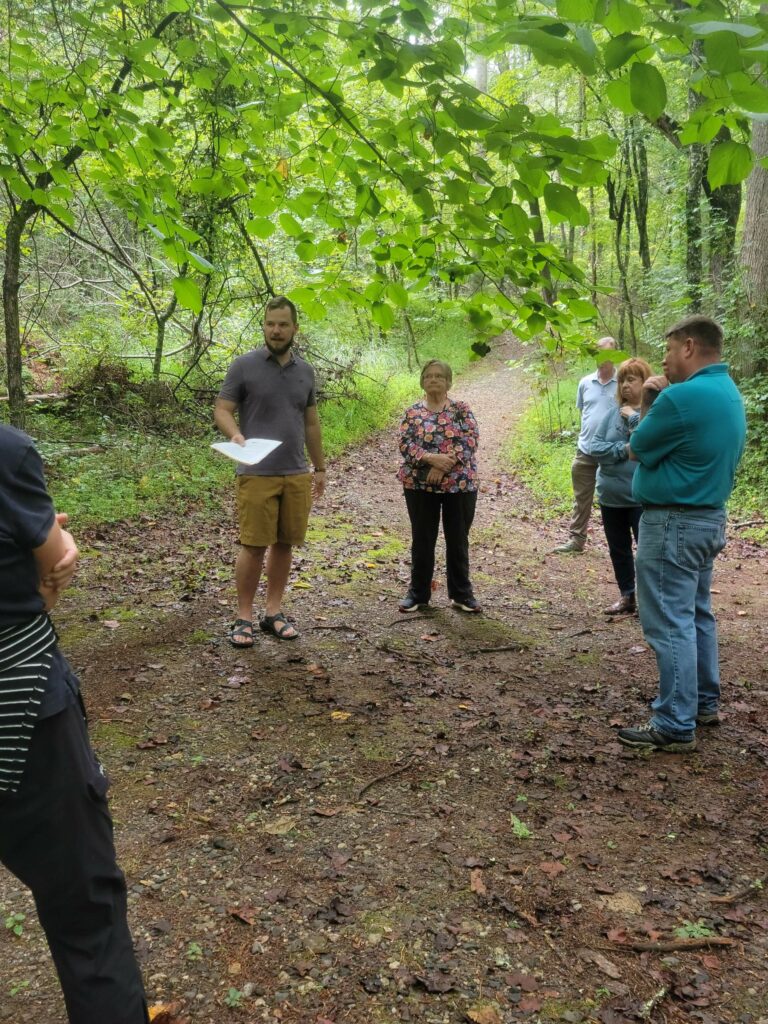
- On the night of Oct 13, the army and prisoners, en route to Morganton (Burke Courthouse) camp at the farm of Aaron Biggerstaff, a Loyalist mortally wounded at Kings Mountain who died after being taken to Union Courthouse in SC.
- Aaron and wife Martha had lived here since 1771. Both he and his brother Benjamin had fought under a Loyalist force in Georgia in 1779, then at Ramsour’s Mill near Lincolnton, then finally at Kings Mountain.
- Aaron’s widow Martha was still here with presumably a man they enslaved.
- Early the next day on the 14th, the commanding officers decided to hold a court martial for some of the prisoners. Some of the presiding officers were justices of peace or magistrates so they would call it a civil trial.
- Earlier that year, the NC Assembly passed a law encouraging speedy trials for treason, empowering local magistrates, regardless of home district of accused, to form juries of free holders and try, sentence, even execute for treason. The accused still retained the right to summon testimony on their behalf.
- These officers decided to try Loyalists officers and some of the most notorious who were accused of wanton murder and other crimes outside the normal course of war – likely making an example, and also lightening their load. A rebel militia officer reportedly stoked the fire, telling Col. Isaac Shelby that he saw British or Loyalists hang 11 rebels in SC a few months prior. Now, for various reasons, the rebel officers would be judge, jury, and executioner.
- Local family members, hearing the news, poured into the camp to beg for the lives of their loved ones.
- Several prisoners got lucky including Samuel Chambers and James Crawford who had deserted to warn Ferguson of the oncoming army. Their neighbors or even former commanders recognized them, vouched for their conduct, and they were spared death, or even allowed to rejoin the local militia. It appears Chambers was specifically spared because of his young age.
- Josiah Brandon story.
- That night, using pine torches for light, the officers tried as many as 36 Loyalists and sentenced at least 9 of them to death. They were:
- Ambrose Mills was most likely made an example of strictly for being a prominent Loyalist leader. Had been on the Tryon Committee of Safety in 1775 but was a known and clear Loyalist throughout war.
- James Chitwood whose brothers were later pardoned by the state and spared death.
- Wilson
- Walter Gilkey was charged with shooting a young rebel boy and stealing his gun. The boy turned out to testify against Gilkey. And Gilkey’s elderly father, despite offering the boy his horse, saddle, and $100 could not buy his son’s life.
- Grimes
- Lafferty (Thomas or James), may have left widow Sarah in Rutherford County.
- John McFall was a noted Loyalist leader in the Burke County area and was sentenced to death at the insistence of Benjamin Cleveland for violence against local citizens. His brother Arthur was saved by Joseph McDowell who knew him.
- John Bibby
- Augustine Hobbs
- Officers set about hanging them from a branch on a large oak tree.
- Anthony Allaire, (who was formerly a lawyer in New York), wrote:
“Saturday, 14th [October]. Twelve field officers were chosen to try the militia prisoners – particularly those who had the most influence in the country. They condemned thirty – in the evening they began to execute Lieut-Col. Mills, Capt. Wilson, Capt. Chitwood, and six others, who unfortunately fell a sacrifice to their infamous mock jury. Mills, Wilson, and Chitwood died like Romans – the others were reprieved.”
- Alexander Chesney, another captured Loyalist, called it a mock trial. He reported 24 convicted and 10 hanged.
- For some reason, the rebels stopped their executions at 9 or 10 people. Some later claimed the army received news that the feared Loyalist force under Banastre Tarleton was on its way toward them.
- Others, including Anthony Allaire, claimed that when one of those sentenced to death, Isaac Baldwin, escaped into the night it changed the mood of the execution.
- Uzal Johnson, a doctor serving under Ferguson, also kept a diary and he wrote:
“They died like Romans, saying they died for their King and his Laws. What Increased this melancholy scene was the seeing Mrs Mills take leave of her Husband, and two of Chitwood’s daughters take leave of their Father. The latter were comforted with being told their Father was pardoned. They went to our Fire where we had made a Shed to keep out the Rain. They had scarce set down when News was brought that their Father was dead. Here words can scarce describe the Melancholy scene, the two Young Ladies swooned away, and continued in fits all night. Mrs Mills, with a Young child in her Arms, set out All Night in the Rain with her Husband’s Corpse, and not even a Blanket to cover her from the inclemency of the Weather.”
- The executions stopped though, and in the pouring rain the next morning, the rebels led their prisoners on a grueling march to Quaker Meadows near Morganton and eventually on to the Moravian Towns around modern Winston Salem.
- In the aftermath, witnesses expresses varied opinions about this event. Georgia Patriot Captain Paddy Carr felt it was justice and later wished “Would to God every tree in the forest bore such fruit as that.”
- Isaac Shelby later remembered decades later “It is impossible for those who have not lived in its midst, to conceive of the exasperation which prevails in a civil war. The execution, therefore, of the nine Tories at [near] Gilbert Town, will, by many persons, be considered an act of retaliation unnecessarily cruel. It was believed by those who were on the ground to be both necessary and proper,”
- On the other hand, General Charles Cornwallis wrote to American General William Smallwood that “I must now observe that the cruelty exercised on the Prisoners taken under Major Ferguson is shocking to humanity; and the hanging poor old Colonel Mills, who was always a fair and open Enemy to your Cause, was an act of the most Savage barbarity.”
- Smallwood responded by sending Cornwallis a list of executed rebels.
Aftermath
- The war never did return to the mountains – save for isolated killings and reprisals based on this animosity.
- Isaac Baldwin, for example, a Loyalist, was killed by a band of Burke County militia a few weeks after Kings Mountain, and his brother reportedly tried to avenge his killing nearly 40 years later
- Before the war was over, we also see a large number of court cases and property confiscations of those accused of Loyalism, as well as some intervention on their behalf.
- Court cases showed that even staunch patriots were willing to aid select Loyalists or their families in several cases. During this time, as trials went on and more and more property was seized, neighbors, family, or sympathetic officers continued to aid some Loyalists by petitioning on their behalf to the state legislature, and many from the backcountry such as Shadrack and Moses Chitwood were pardoned and spared death.
- In July, 1782, we get a sense of the scope. In a case before the Morgan district superior court, 113 men accused of treason (specifically for serving with Ferguson) were found guilty and their property was liable for confiscation. These were just men listed as residing in Rutherford County
- It looks like, from my research, just over half of the implicated people, that is those affiliated with loyalism to some degree, had their cases presented in court, and maybe a little more than half of those had their property confiscated. Interestingly, any confiscated property from the area was never officially reported to the state, leaving several questions.
- Many, perhaps the majority of the accused loyalists here actually stuck around and seemingly escaped confiscation.
- Some, like Jonas Bedford, fled to other counties, states, or even England in Bedford’s case.
- This is where women were of incredible importance to the fate of the Loyalists, and where they took an active role in the political sphere.
- NC and several other states made some provisions for allowing Loyalist widows or those whose husbands deserted to keep some land and property to provide for themselves.
- Loyalist wives and mothers got others to sign petitions on their behalf and appealed to the legislature, often managing to hold the family estates. They also appraised the exiled men of the political and social climate and let them know when it was safe to come home.
- Martha Biggerstaff was allowed to keep all the property (except enslaved people) that her husband had owned, and his trial for treason and confiscation was to be laid over until next superior court – appears charges not prosecuted
- Mary Biggerstaff, wife of Benjamin who was deceased by early 1782, received protection from the superior court against any judgements against husband’s estate, allowing her to keep part of husband’s property and allowed to sell or collect accounts belonging to Benjamin.
- As a result of Mercy Bedford’s petitioning, Jonas was able to come home after several years in England and lived the rest of his life comfortably in Rutherford County.
- Jonas Bedford was also one of a handful of accused or actual Loyalists to achieve great success or popularity despite his past. He was also elected to the state legislature and served several local offices.
- William Green, another Rutherford County Loyalist who was convicted and who had lands confiscated was elected to the state legislature 4-5 times in the 1810s.
- The Mills family also became very successful and named Ferguson Peak in the Hickory Nut Gorge after the deceased commander.
- Yet, court records also tell us that many of those accused or truly guilty of various shades of Loyalism simply moved away or fled. The trial records of the Morgan District Criminal Court from the early 1780s are littered with cases where accused Loyalists simply forfeited their property – that is, they never showed up to court, presumably after moving away.
- Confiscations ended after NC ratified the Treaty of Paris ratified in 1784 and it seems Loyalists who remained peacefully came to terms with their neighbors, including those who fought against them. This was probably made easier as more and more of the settlers in the mountains continued pushing further west and many bitter feelings had a chance to dissipate geographically over the next few decades.
What Happened to the Bodies?
- We know at least a few bodies were left hanging on the oak tree which was at a crossroads.
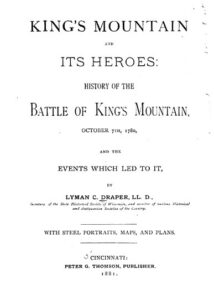
Kings Mountain and Its Heroes by Lyman C. Draper. - Historian Lyman Draper noted 100 years later that the tree still stood and was known as the gallows oak. It was cut in the early 1950s.
- Martha Biggerstaff and the unknown man living there were left to cut down the hanging bodies.
- Ambrose Mills was carried away to what is now Polk County by his widow according to Allaire’s account.
- Writing 100 years later, Lyman Draper took accounts from local residents and wrote that 8 of the 9 bodies were buried nearby in a shallow 2-foot grave.
- Draper, however, from local correspondence, claimed that James Chitwood was the one buried elsewhere, at the nearby home of Benjamin Bickerstaff on a hill still used as graveyard in 1880. My best guess is that may be the modern Mt. Lebanon Church cemetery.
- Per Draper:
“About 1855, a party of road-makers concluded to exhume the remains of Colonel Mills and his companions, as the place of their burial was well known. The graves of only four of the number were opened, the bones soon crumbling on exposure. Several articles were found in a very good state of preservation — a butcher knife, a small brass chain about five inches in length, evidently used in attaching a powder horn to a shot bag, a thumb lancet, a large musket flint, a goose quill, with a wooden stopper, in which were three or four brass pins . These articles, save the knife, and a portion of the pins, are preserved by M. O. Dickerson, Esq, of Rutherfordton.”
The Site Today
- Lyman Draper suggested that only the red chimneys of the house stood when he wrote about it in 1880.
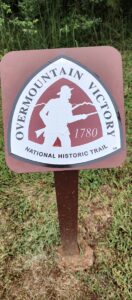
The Biggerstaff site and Brittain Church are both stops along the Overmountain Victory National Historic Trail - An archaeological survey in the early 2000s didn’t find evidence of an army encampment or homestead, but this is known to be part of the historic Biggerstaff farm and likely close to the hanging spot.
- The survey found road traces that could date to Revolutionary War period and which were probably used until the 1850s.
- Rutherford County acquired this property in 2010 and is part of the Overmountain Victory National Historic Trail.
We don’t know where the graves are and may never know. Like so many of the stories we discussed today, we can never get a complete chronicle of every event, location, personal feelings, or thought from the people we discussed. History is an investigation into the past based on the best evidence we have available, and that is rarely complete. But still, I hope we can find some meanings and make sense of the past and feel a more tangible connection to it through the glimpses these sites provide.
August 31, 2023

